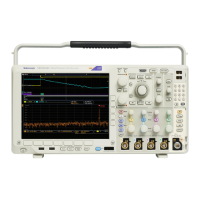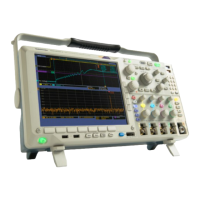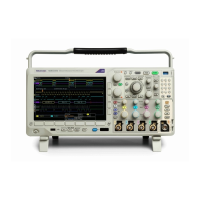Commands Listed in Alphabetical Order
HARMonics Use t
he harmonics functions to obtain the frequency spectrum of the
source waveform and associated measurement values. Harmonic measurements
can help one perform in-depth troubleshooting of power quality problems.
RIPPle Use the ripple functions to obtain measurements and statistics for the
AC components of the acquired waveform. Ripples are often found on top of a
large DC signal.
MODULationanalysis Use the modulation functions to obtain a trend plot of a
measurement value across the acquired waveform. This is useful for showingthe
variations in the modulated switching signal.
DESKew Run the deskew procedure to match the delays through the probes.
Different probes introduce different delays between the probe tip and the
oscilloscope. Many oscilloscope users do not have to worry about this because
they use
the same type of probe on all channels. Power measurement users,
however, frequently use both a voltage probe and a current probe. A current
probe typically has a larger delay than a voltage probe, so setting deskew values
becomes important.
Examples
POWER:TYPE HARMonics sets the measurement type to Harmonics.
POWER:TYPE? might return POWER:TYPE NON indicating that no measurement
type is set.
POWer:VOLTAGESOurce
This command specifies the voltage source for the power application.
Conditions
This command requires a DPO4PWR application module for 4000 series models,
or an MDO3PWR application module for MDO3000 series models.
Group
Power
Syntax
POWer:VOLTAGESOurce {CH1|CH2|CH3|CH4|REF1|REF2| REF3|REF4}
POWer:VOLTAGESOurce?
Arguments
CH1–CH4 or REF1–REF 4 sets the analog channel 1–4 or reference waveform
1–4 as the voltage source.
Examples
POWER:VOLTAGESOURCE CH1 sets the voltage source as CH1.
POWER:VOLTAGESOURCE? might return POWER:VOLT AGESOURCE CH1 indicating
that the voltage source is set to CH1.
2-536 MDO4000/B/C, MSO/DPO4000B and MDO3000 Series Oscilloscopes Programmer Manual

